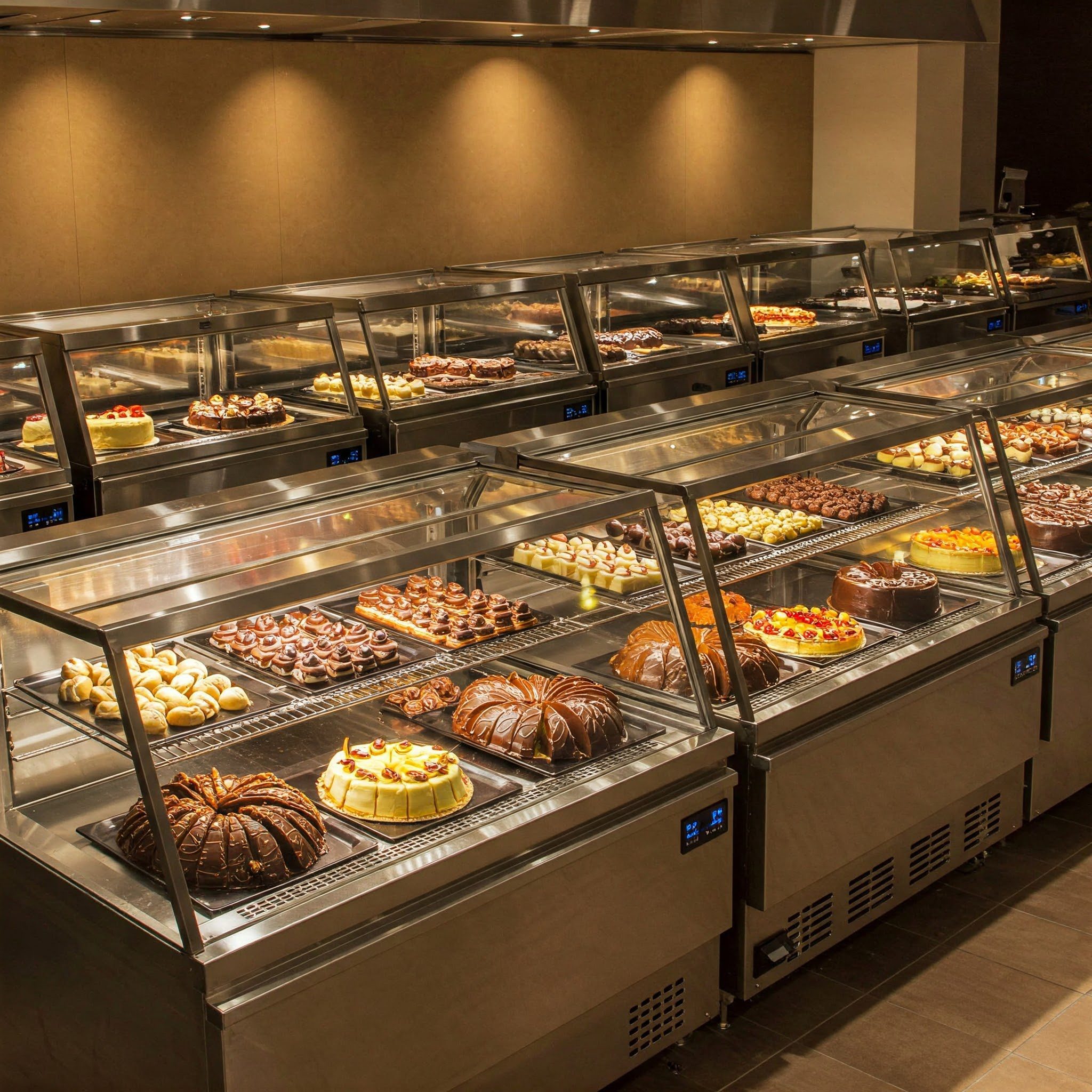Chocolate and Cake Displays: Elegance Meets Refrigeration
Commercial chocolate display fridges and cake display cabinets require precise conditions to preserve delicate products. When these units malfunction, quick diagnosis is vital to avoid spoilage. This guide provides a troubleshooting guide for the 10 most commonly used commercial chocolate and cake display machines in the UK, including fault code meanings, typical faults, and diagnosis procedures. We reference official manuals and service tips, and include maintenance tips to keep your display running optimally. Use this as a high-level cake display troubleshooting guide – always refer to the official service manual for detailed instructions.
Covered Brands/Models: Williams (Jewellery Box & Cake Display), Foster (Patisserie series), Polar (display fridges), Interlevin (patisserie cabinets), Blizzard (cake displays), Tefcold (display units), ISA (Italian showcases), Tecfrigo (display cabinets), Everlasting (chocolate fridges), Roller Grill (countertop chocolate fridge). Each section includes fault code tables (where applicable) and references to official manuals or technical resources in the UK.
Types of Chocolate and Cake Displays
1. Countertop Cake Displays
- Description: Compact, tabletop units designed for small-scale displays.
- Best For: Cafes, small bakeries, or home use.
- Example Items: Cupcakes, small cakes, and chocolates.
2. Upright Cake Displays
- Description: Vertical, multi-shelf display units with glass doors, allowing maximum storage capacity.
- Best For: Patisseries, bakeries, and supermarkets.
- Example Items: Layered cakes, desserts, and specialty chocolates.
3. Rotating Cake Displays
- Description: Circular units with rotating trays to provide a 360-degree view of the desserts.
- Best For: High-end cafes and bakeries.
- Example Items: Celebration cakes, tiered cakes, and decorative desserts.
4. Chocolate Displays with Humidity Control
- Description: Specialized units with precise temperature and humidity controls to protect chocolates from melting or losing their texture.
- Best For: Chocolate shops and artisan chocolatiers.
- Example Items: Truffles, pralines, and gourmet chocolates.
5. Open-Front Displays
- Description: Refrigerated units without doors for self-service.
- Best For: High-traffic areas in retail stores or cafes.
- Example Items: Grab-and-go desserts, pastries, and chocolates.
Key Features of Chocolate and Cake Displays
- Temperature Control
- Adjustable settings to maintain the ideal range (4°C to 8°C for cakes, 15°C to 18°C for chocolates).
- Humidity Control
- Prevents chocolates from “blooming” (white streaks caused by moisture) and keeps cakes fresh.
- Glass Panels
- Tempered, anti-fog glass ensures visibility and enhances the presentation of the desserts.
- LED Lighting
- Soft, energy-efficient lighting highlights the details and colors of the displayed items.
- Adjustable Shelving
- Flexible arrangements to accommodate desserts of various sizes and heights.
- Rotating Trays
- Allows customers to view items from all angles, especially useful for decorative cakes.
- Energy Efficiency
- Modern models often come with energy-saving compressors and insulation.
- Elegant Design
- Sleek finishes and modern aesthetics to match the ambiance of the establishment.
Benefits of Chocolate and Cake Displays
- Enhanced Presentation
- Attracts customers with visually appealing arrangements of desserts.
- Preservation of Quality
- Maintains the taste, texture, and appearance of delicate items.
- Versatility
- Suitable for various desserts, from cupcakes and mousse to truffles and chocolate bars.
- Convenient Access
- Allows customers or staff to retrieve items easily.
- Space Optimization
- Available in different sizes to fit various store layouts.
Applications of Chocolate and Cake Displays
- Bakeries and Patisseries: For showcasing layered cakes, pastries, and cupcakes.
- Chocolate Shops: For storing and presenting artisanal chocolates and truffles.
- Cafes and Restaurants: For displaying desserts and grab-and-go items.
- Hotels and Catering: For presenting desserts at events or in buffet settings.
- Retail Stores: For packaged desserts and chocolate bars.
Maintenance Tips for Chocolate and Cake Displays
Daily Maintenance
- Clean Glass Panels: Use a soft cloth and mild glass cleaner to remove smudges and maintain clarity.
- Organize Products: Arrange items neatly to maximize visibility and airflow.
Weekly Maintenance
- Clean Interior Surfaces: Wipe down shelves and trays with a food-safe cleaner to prevent odors.
- Check Temperature Settings: Verify that the unit is maintaining the correct temperature and humidity.
Monthly Maintenance
- Inspect Door Seals: Ensure gaskets are intact to avoid air leaks and temperature fluctuations.
- Clean Condenser Coils: Use a vacuum or brush to remove dust and maintain cooling efficiency.
Seasonal Maintenance
- Defrost (If Manual): Remove frost buildup to ensure consistent cooling performance.
- Service Refrigeration System: Have a professional technician inspect the compressor and other components.
General Maintenance Tips for Chocolate & Cake Displays (UK)
Preventive maintenance goes a long way in avoiding faults for commercial chocolate fridge displays and cake fridges. Here are high-level maintenance tips and best practices:
-
Clean Condensers Regularly: The #1 cause of cooling issues is a clogged condenser. Plan a monthly cleaning schedule. Use a brush or vacuum to remove dust from condenser coils. This prevents overheating and high-pressure faults.
-
Check Door Seals: Damaged or loose door gaskets let warm, moist air in, causing temperature fluctuations and ice build-up. Inspect seals for tears or gaps and clean them from food residue. Replace worn seals to maintain an airtight display.
-
Avoid Overloading & Blockage: Do not over-pack the display case. Leave space for air circulation between products. Ensure fans (if any) aren’t blocked by cakes or wrappers. Proper airflow keeps temperatures even throughout.
-
Defrost When Necessary: Many cake displays are auto-defrost, but if you notice frost accumulation (especially in chocolate fridges running at warmer temps), initiate a manual defrost. For example, turning off the unit overnight can melt ice build-up on the evaporator. Always wipe out water from the drip tray afterwards.
-
Ambient Conditions: Commercial chocolate fridges in particular are sensitive to room conditions. Keep the ambient temperature and humidity within the manufacturer’s specified range (often ≤ 25 °C and ~60% RH). High ambient heat forces displays to work harder, leading to faults. Position the display away from direct sunlight, ovens, or HVAC drafts.
-
Electrical Checks: Ensure the unit is on a dedicated circuit if possible. For any fridge not powering on, always check the basics – is the outlet live and correct voltage, is the plug fully inserted, has the plug fuse blown?. Keeping a log of any tripped breakers or blown fuses can help identify if there’s an underlying electrical issue.
-
Regular Servicing: Schedule a professional service at least annually. A refrigeration engineer will clean condenser coils deeply, check refrigerant pressures, test the thermostat calibration, and verify fans and electrical components. This can catch issues early (e.g., a condenser fan drawing high amps, or a door heater strip failing) before they cause a breakdown. As one service company advises, “have your refrigeration regularly serviced to help keep it in good working order and pick up on any issues before they develop.”.
-
Keep a Temperature Log: Especially in UK commercial settings, it’s good practice (and often a health requirement) to record the display fridge temperature daily. If you notice trends like rising temps, investigate before a fault occurs. This log can also help an engineer diagnose if the issue is intermittent.
By following these maintenance tips, you’ll reduce the likelihood of emergencies and extend the lifespan of your chocolate and cake display units. Remember that timely troubleshooting can save your stock – if a fault code or alarm appears that you’re unsure about, consult the manual or reach out to a qualified repair service for cake displays in the UK. They can provide specialized assistance and ensure your showcase is back to preserving treats at the perfect temperature.
Choosing the Right Chocolate and Cake Display
- Capacity: Choose a size that fits your storage and display needs.
- Temperature and Humidity Control: Ensure the unit can maintain the right environment for your products.
- Design: Opt for a unit that complements your store’s decor and branding.
- Energy Efficiency: Look for models with energy-saving features to reduce operational costs.
- Ease of Cleaning: Select displays with removable trays and shelves for easy maintenance.
Chocolate and Cake Display Fault Diagnosis Guide (UK)
Commercial chocolate display fridges and cake display cabinets require precise conditions to preserve delicate products. When these units malfunction, quick diagnosis is vital to avoid spoilage. This guide provides a troubleshooting guide for the 10 most commonly used commercial chocolate and cake display machines in the UK, including fault code meanings, typical faults, and diagnosis procedures. We reference official manuals and service tips, and include maintenance tips to keep your display running optimally. Use this as a high-level cake display troubleshooting guide – always refer to the official service manual for detailed instructions.
Covered Brands/Models: Williams (Jewellery Box & Cake Display), Foster (Patisserie series), Polar (display fridges), Interlevin (patisserie cabinets), Blizzard (cake displays), Tefcold (display units), ISA (Italian showcases), Tecfrigo (display cabinets), Everlasting (chocolate fridges), Roller Grill (countertop chocolate fridge). Each section includes fault code tables (where applicable) and references to official manuals or technical resources in the UK.


